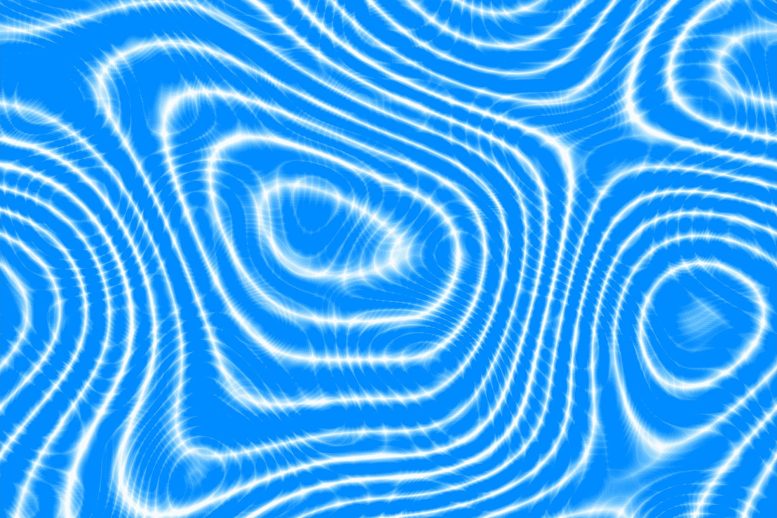
Mathematicians have discovered that moiré patterns formed by rotating and stretching one lattice relative to another may be used to design a variety of composite materials. Their electrical and other physical characteristics can change—sometimes dramatically—depending on whether the resultant moiré patterns are regularly repeating or non-repeating.
You’re probably familiar with moiré patterns, the large-scale interference patterns known in mathematics, physics, and art. They are created by overlaying one ruled opaque pattern with transparent gaps over another similar pattern. When they are rotated or displaced, the interference pattern appears.
Moiré patterns have shown to be especially useful with 2D-materials, single layer materials are lattices consisting of a single layer of atoms. Graphene, a single layer of atoms arranged in a two-dimensional honeycomb lattice nanostructure is one of the most well-known 2D-materials. When you take two stacked layers of graphene, twisted at the magic angle, all kinds of powerful properties can emerge such as superconductivity and ferromagnetism.
Now scientists have discovered a new range of composite materials they can design from moiré patterns with unique electrical and physical characteristics.

Two concentric circles, moving parallel to each other, create moiré patterns. Credit: Jacopo Bertolotti
Look at the image above.
Watch for the patterns created as the circles move across each other. Those patterns, created by two sets of lines offset from each other, are called moiré (pronounced mwar-AY) effects. As optical illusions, moiré patterns create neat simulations of movement. But at the atomic scale, when one sheet of atoms arranged in a lattice is slightly offset from another sheet, these moiré patterns can create some exciting and important physics with interesting and unusual electronic properties.
Mathematicians at the University of Utah have found that they can design a range of composite materials from moiré patterns created by rotating and stretching one lattice relative to another. Their electrical and other physical properties can change—sometimes quite abruptly, depending on whether the resulting moiré patterns are regularly repeating or non-repeating. Their findings are published in Communications Physics.
The mathematics and physics of these twisted lattices applies to a wide variety of material properties, says Kenneth Golden, distinguished professor of mathematics. “The underlying theory also holds for materials on a large range of length scales, from nanometers to kilometers, demonstrating just how broad the scope is for potential technological applications of our findings.”
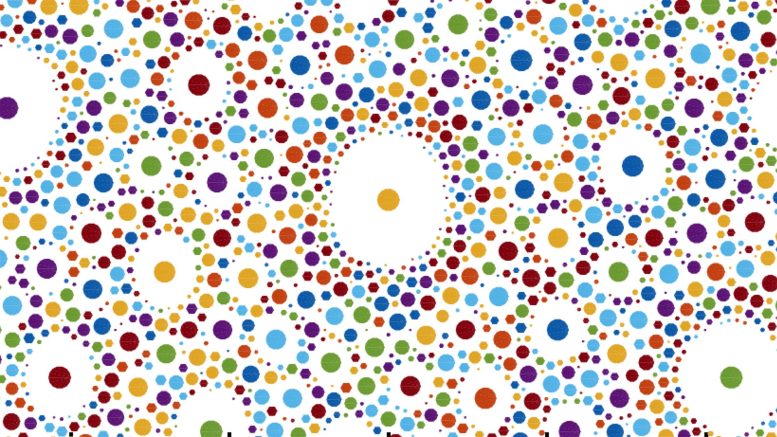
Fractal arrangement of periodic systems. Dots identify Moiré parameter values corresponding to systems with periodic microgeometry, where short and large periods are identifed by large and small dots, respectively, revealing self similar, fractal arrangements of periodic systems. Credit: Courtesy of Ken Golden/University of Utah
With a twist
Before we arrive at these new findings, we’ll need to chart the history of two important concepts: aperiodic geometry and twistronics.
Aperiodic geometry means patterns that don’t repeat. An example is the Penrose tiling pattern of rhombuses. If you draw a box around a part of the pattern and start sliding it in any direction, without rotating it, you’ll never find a part of the pattern that matches it.
Aperiodic patterns designed over 1000 years ago appeared in Girih tilings used in Islamic architecture. More recently, in the early 1980s, materials scientist Dan Shechtman discovered a crystal with an aperiodic atomic structure. This revolutionized crystallography, since the classic definition of a crystal includes only regularly repeating atomic patterns, and earned Shechtman the 2011 Nobel Prize in Chemistry.
Okay, now onto twistronics, a field that also has a Nobel in its lineage. In 2010, Andre Geim and Konstantin Novoselov won the Nobel Prize in Physics for discovering graphene, a material that’s made of a single layer of carbon atoms in a lattice that looks like chicken wire. Graphene itself has its own suite of interesting properties, but in recent years physicists have found that when you stack two layers of graphene and turn one slightly, the resulting material becomes a superconductor that also happens to be extraordinarily strong. This field of study of the electronic properties of twisted bilayer graphene is called “twistronics.”
Two-phase composites
In the new study, Golden and his colleagues imagined something different. It’s like twistronics, but instead of two layers of atoms, the moiré patterns formed from interfering lattices determine how two different material components, such as a good conductor and a bad one, are arranged geometrically into a composite material. They call the new material a “twisted bilayer composite,” since one of the lattices is twisted and/or stretched relative to the other. Exploring the mathematics of such a material, they found that moiré patterns produced some surprising properties.
“As the twist angle and scale parameters vary, these patterns yield myriad microgeometries, with very small changes in the parameters causing very large changes in the material properties,” says Ben Murphy, co-author of the paper and adjunct assistant professor of mathematics.
Twisting one lattice just two degrees, for example, can cause the moiré patterns to go from regularly repeating to non-repeating—and even appear to be randomly disordered, although all the patterns are non-random. If the pattern is ordered and periodic, the material can conduct electrical current very well or not at all, displaying on/off behavior similar to semiconductors used in computer chips. But for the aperiodic, disordered-looking patterns, the material can be a current-squashing insulator, “similar to the rubber on the handle of a tool that helps to eliminate electrical shock,” says David Morison, lead author of the study who recently finished his Ph.D. in Physics at the University of Utah under Golden’s supervision.
This kind of abrupt transition from electrical conductor to insulator reminded the researchers of yet another Nobel-winning discovery: the Anderson localization transition for quantum conductors. That discovery, which won the 1977 Nobel Prize in Physics, explains how an electron can move freely through a material (a conductor) or get trapped or localized (an insulator), using the mathematics of wave scattering and interference.
However, Golden says that the quantum wave equations Anderson used don’t work on the scale of these twisted bilayer composites, so there must be something else going on to create this conductor/insulator effect. “We observe a geometry-driven localization transition that has nothing to do with wave scattering or interference effects, which is a surprising and unexpected discovery,” Golden says.
The electromagnetic properties of these new materials vary so much with just tiny changes in the twist angle that engineers may someday use that variation to precisely tune a material’s properties and select, for example, the visible frequencies of light (a.k.a. colors) that the material will allow to pass through and the frequencies it will block.
“Moreover, our mathematical framework applies to tuning other properties of these materials, such as magnetic, diffusive, and thermal, as well as optical and electrical,” says professor of mathematics and study co-author Elena Cherkaev, “and points toward the possibility of similar behavior in acoustic and other mechanical analogues.”
Reference: “Order to disorder in quasiperiodic composites” by David Morison, N. Benjamin Murphy, Elena Cherkaev and Kenneth M. Golden, 14 June 2022, Communications Physics.
DOI: 10.1038/s42005-022-00898-z

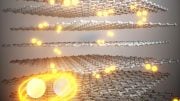
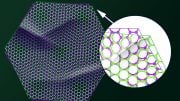



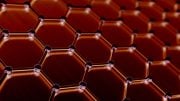
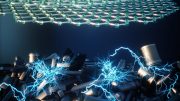
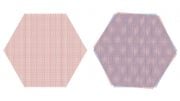
Be the first to comment on "With a Twist: New Composite Materials With Highly Tunable Electrical and Physical Properties"